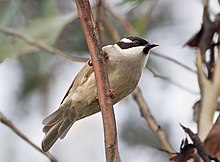Strong-billed honeyeater
| Strong-billed honeyeater | |
|---|---|
 |
|
| Scientific classification | |
| Kingdom: | Animalia |
| Phylum: | Chordata |
| Class: | Aves |
| Order: | Passeriformes |
| Family: | Meliphagidae |
| Genus: | Melithreptus |
| Species: | M. validirostris |
| Binomial name | |
|
Melithreptus validirostris (Gould, 1837) |
|
| Synonyms | |
|
Eidopsarus bicinctus Swainson |
|
Eidopsarus bicinctus Swainson
The strong-billed honeyeater (Melithreptus validirostris) is a species of bird in the family Meliphagidae. It is one of two species of the genus Melithreptus endemic to Tasmania. Its natural habitat is temperate forests.
The strong-billed honeyeater was first described by ornithologist John Gould in 1837. Its specific name is derived from the Latin words validus "strong", and rostrum "bill". It is a member of the genus Melithreptus with several species, of similar size and (apart from the brown-headed honeyeater) black-headed appearance, in the honeyeater family Meliphagidae. Molecular markers show the strong-billed honeyeater separated from the common ancestor of the brown-headed and black-chinned honeyeaters between 6.7 and 3.4 million years ago.
The next closest relative outside the genus is the much larger but similarly marked blue-faced honeyeater. More recently, DNA analysis has shown honeyeaters to be related to the Pardalotidae (pardalotes), Acanthizidae (Australian warblers, scrubwrens, thornbills, etc.), and the Maluridae (Australian fairy-wrens) in a large Meliphagoidea superfamily.
A mid-sized honeyeater at 16.5–17.5 cm (6.5–7 in) in length, it is olive brown above and pale grey brown below, with a black head, nape and throat white patch over the eye and a white crescent-shaped patch on the nape. Juveniles have brownish crowns, lemon tinged nape and an orange base of bill. Its call is a loud cheep cheep, or a churring.
...
Wikipedia

